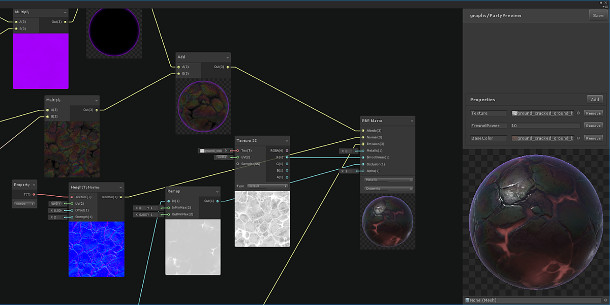Unity Technologies releases Unity 2018.1 in beta

Unity 2018.1’s node-based shader editor. The release, which is currently available in beta, also introduces a user-customisable architecture for render pipelines, and removes native support for Substance materials.
Unity Technologies has released Unity 2018.1, the first of this year’s cycle of updates to the game engine and development environment, in beta.
The release introduces Unity’s much-anticipated new Scriptable Render Pipeline and a new node-based shader editor, but removes native support for Substance materials, now handled via a free third-party plugin.
New Scriptable Render Pipeline lets users create custom render loops for specific platforms
The big change in Unity 2018.1 is the Scriptable Render Pipline (SRP): a new work-in-progress render architecture that supersedes Unity’s existing fixed forward and deferred rendering loops.
First announced at GDC 2017, SRP enables users to create custom render pipelines tailored to specific hardware platforms or build targets by coding them in C#.
The initial implementation comes with two readymade templates: a Lightweight setup aimed at cross-platform builds, and a High-Definition setup for PCs and consoles.
New built-in node-based shader editor
The SRP is complemented by a new node-based shader graph – the first of several upcoming visual programming tools according to that same GDC keynote.
As well using the standard nodes, users can create their own custom nodes via C# or HLSL, and can select which parts of the shader to make editable through the Material Inspector.
Materials in Substance format now supported via upcoming free third-party plugin
And as one node-based material-creation system enters, another one departs: as of Unity 2018.1, materials in Allegorithmic’s Substance format will no longer be natively supported inside Unity.
Unity will still be able to read .sbsar files via a free third-party plugin maintained by Allegorithmic, which will also incorporate its existing Substance Source integration plugin and Substance Painter live link.
According to Unity Technologies’ forum post, the motivation is “to make the Unity editor as lightweight and modular as possible”, but it should also enable Allegorithmic to support newer features of its Substance technology, as it recently did with the integration for 3ds Max, also now a standalone plugin.
Other new features: stereoscopic 360-degree recording, new GI options
Other new features in Unity 2018.1 include the option to render stereoscopic 360-degree footage as cubemaps or in equirectangular format, for use in virtual reality projects.
The Progressive Lightmapper gets experimental support for baking sky occlusion; and both global illumination and mesh rendering of particle systems now support GPU instancing.
There is also an experiemental new API for sprite animation.
So far, there isn’t much information on these features, beyond bare-bones descriptions in the online release notes, but Unity Technologies says that it will post more details over the course of the beta cycle.
Pricing and availability
Unity 2018.1 is available in beta for Windows 7+ and Mac OS X 10.11+.
Unity is available on a rental-only basis: free Personal subscriptions have a non-editable splash screen and can be used by anyone with revenue of up to $100,000/year.
Paid Plus and Pro plans cost $35/seat/month and $125/seat/month respectively.
Read more about the new Scriptable Render Pipeline and shader editor on Unity Technologies’ blog
Read a full list of new features in the Unity 2018.1 beta in the online release notes
